Daggerheart review — more than a heartbreaker

Daggerheart manages to stand above the large crowd of challengers to D&D’s dominance of the marketplace. While undeniably influenced by that game, it takes genuine steps away from the assumptions and mechanics that hold it back from being the experience that many approach it for. The Fear and Hope rules offer narrative depth from every dice roll, and despite feeding into meta-currencies, avoid awkward record-keeping. They integrate well with the rules, and make for a smooth, organic game. While we do have some criticisms about specific rules and the combat-heavy nature of the design, the meat of this game is strong, inventive, and universally high quality. With recent talent acquisitions and a dagger to grind, Darrington is making no bones about its serious ambitions to justify itself as game makers and actual players both.
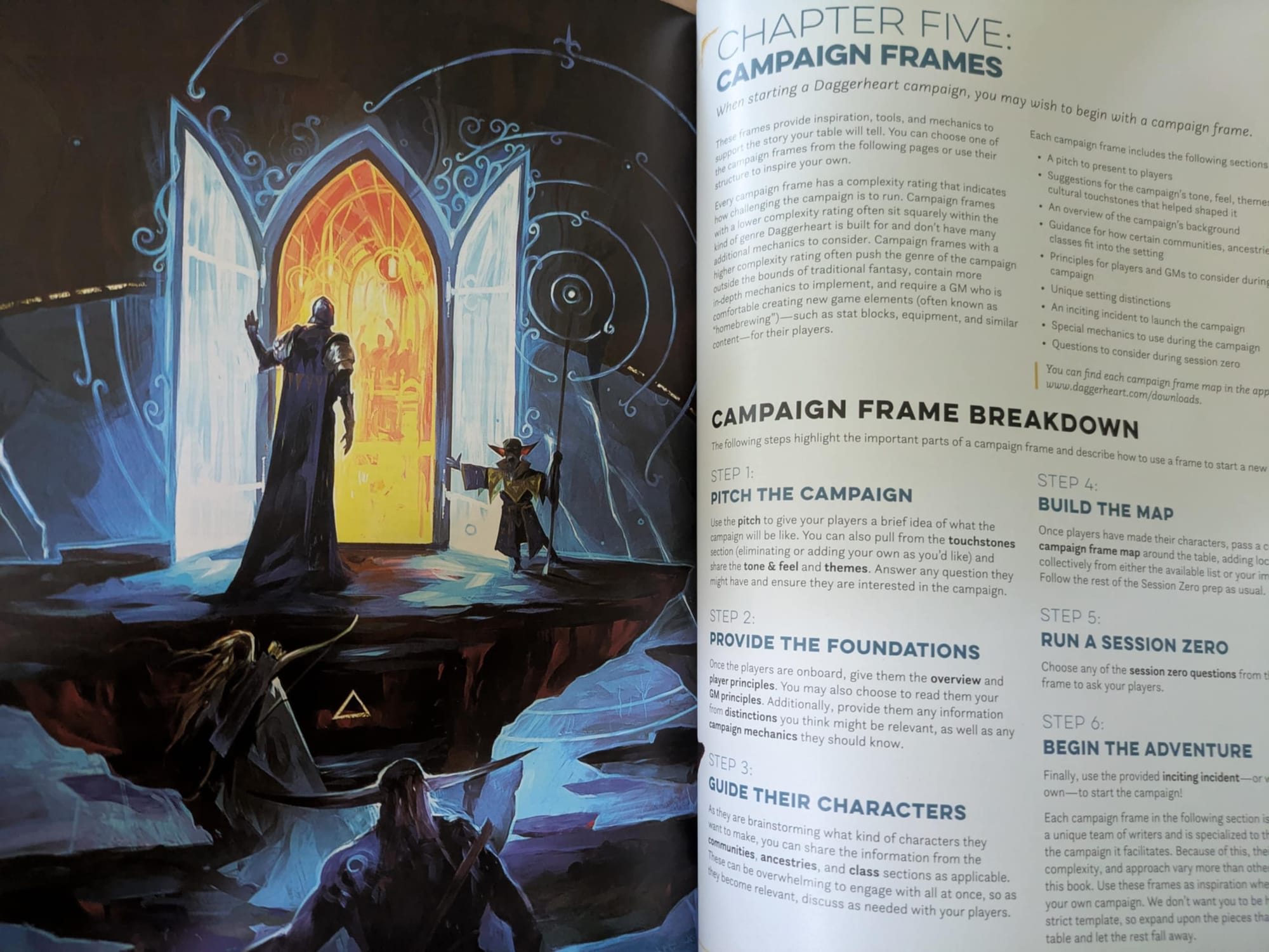
Setting the Stage – John
Skip this if you need to. Daggerheart has caused me to look back on writing RPG reviews and how it makes me approach this game. I hope not to be self indulgent, but we need to talk about the state of D&D and Darrington Press as this is coming out, so you’ll understand why I’m so hard on a game I actually end up liking quite a bit.
Back in the day, I was interested in aspects of 5E that ended up not working out as I expected. I gave it a 95 back in 2014, but over the years, I’ve found I would modify that score substantially. There was an encroachment of lots of little issues that kept the experience from being what the mechanics told me it was. It took a few years of differing playstyles to make me realize that. The same happened with Savage Worlds. I played standard, Swade, Deadlands, Rippers, and probably a few others before it solidified for me that I disliked the game, and why. I have not played a ton of Daggerheart, and my feelings will surely get more complicated over the years. What I am sure of is that I will use specific examples to justify how I feel about this game. Those feelings are complicated in their specifics, but very positive in their generalities.
There have been more than a few significant improvements since the playtest. Ones that prove the designers reacted thoughtfully to that feedback in their game design, if not in their marketing. Issues that have been resolved that I wish they would boost more, like the initiative system and functionality of the cards.
Rowan and Spencer said to me that they see Daggerheart as lying between Powered by the Apocalypse and D&D. I found that an interesting statement; as you can see from my Urban Shadows 2e review, D&D and PBTA are differentiated more philosophically than mechanically. It’s more about a different approach to how an RPG should function than how the rules work. That said, I think I know what they mean: something between the two in general weight of mechanics, with some story-game influences to cut down on the page flipping and jargon.
Overall, this is a good game with high production quality that I think is far superior to the D&D that people try to play, which is different from what D&D is actually designed to be. What I mean by that is that D&D suffers a lot from people trying to make it something it isn’t: D&D is a game about survival and attrition, where CR and people it’s influenced are trying to play a more lighthearted, character-focused story. People aren’t supposed to die often in those narratives, which doesn’t work all that well in a game built with all of its rules around combat. In practice, D&D’s battles can often become boring. Part of that is mechanical, i.e., the rarity of significant vulnerabilities, the HP bloat, and how most characters have one strategy that they should be using every turn of every fight. But it’s also partially because players ignore important rules, refuse to learn the rules, and spend time having to figure out and relearn aspects of their character or the combat encounter that they should already be aware of.
If you don’t use encumbrance, rations, ammunition, spell components, and donning/doffing rules, of course the combats are going to be weightless and tedious. Of course the game will lack a significant feeling of exploration. You’ve just surgically removed all of the mechanics that would have supported that feeling. I’m not saying you’re wrong to play this way. I’m saying you’re putting a lot of effort into adjusting a game that isn’t interested in or built to be adjusted that way. “It’s easier to hack something you know than learn a new game” is a statement I hear a lot, but is written in complete ignorance of how easy it is to learn other games. Games that are usually free or less expensive, with more accessible community tools, and more interesting decisions or specific tones.
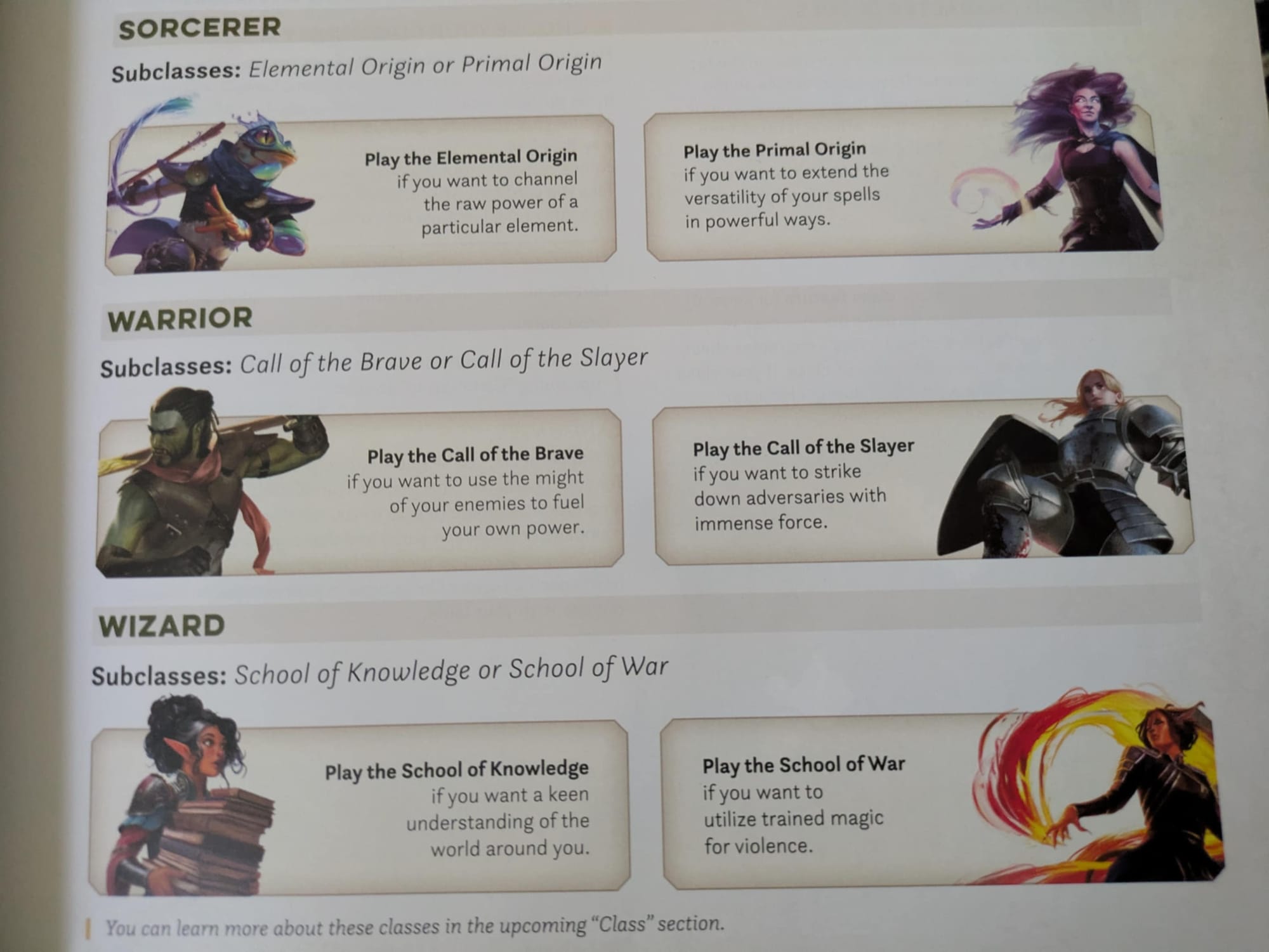
D&D’s dominance is because of marketing, not superior quality. There are already tons of games that are better at everything it accomplishes mechanically, other than being named Dungeons and Dragons. That’s why trying to make a game targeted at that audience is likely to fail. If it can be done, would it have already? If anyone was going to try, it might as well be Darrington Press. Critical Role was more responsible for 5e’s marketing than anything Hasbro themselves ever did. I do not follow CR much, but that’s due to the quality of their work. It’s because I have no patience at all, and they have like 400 episodes that are all over 3 hours long. Moreover, my impatience makes me most interested in structured, edited art. I like how an artist’s intention refines and builds a piece, with its many segments working towards a deliberate focus. As soon as anyone goes “uh is that a move action or a main action? Let’s see, it’s in the combat section, okay [page flips]…” I have lost interest, and you are unlikely to get me back. There’s a lot to be said for the passion and quality, respect for their audience, and themselves that CR represents. My issue is with the medium of actual plays themselves.
All of that is secondary to the fact that Hasbro has shown itself to be a vile organization, sure to destroy any potential or quality that Wizards of the Coast might have remaining. Everyone I can think of who felt like a leader in what WotC did well are now gone and never coming back. Jeremy Crawford and Chris Perkins even work at Darrington now. It’s time to move on, and Daggerheart is a good place to go. It loses something in how closely it’s tied to D&D, with a non-setting full of dwarves and elves that could have gone farther to strike out on its own. Similarly, as much as this is streamlined, it is still fundamentally a fantasy combat game. All that comes together into something worthy because fantasy combat games are still a ton of fun, and this is built with more focus and less cruft than 5E ever was. That said, with the strengths and vision working at the heart of this daggery game, they could have made something bolder, that stands out more, by getting out from under the shadow of Wizards of the Coast.
MIKE doesn’t yell at clouds: As a TTRPG player going back to the early eighties, it would be easy for me to settle into an “old man yelling at the clouds” stance regarding anything happening in the space right now (and I see those guys all over social media grousing about everything from their distaste of current art styles to granular rules mechanics), but any urges of that nature are overcome by the sheer creativity of modern designers and the widespread popularity that one of my favorite hobbies has finally achieved. There is much hand–wringing about D&D 5E’s hegemony in the market, and much of the criticism is earned, but it can’t be denied that its success has lifted the industry to new heights and paved the way for a new renaissance in the space. That said, the current wave of high profile releases is largely due to the OGL fiasco in early 2023, which is playing out to be the biggest “attack of opportunity” on the franchise since the early days of the game. Why? Because the rise of D&D in the last decade wasn’t just brought about by WOTC, it was also the result of hard work by other people and companies creating for the game, and none are bigger than the actual players of Critical Role, who built a media empire out of what started as their weekend game of D&D. Darrington Press is the publishing arm of that empire, and Daggerheart is their response.
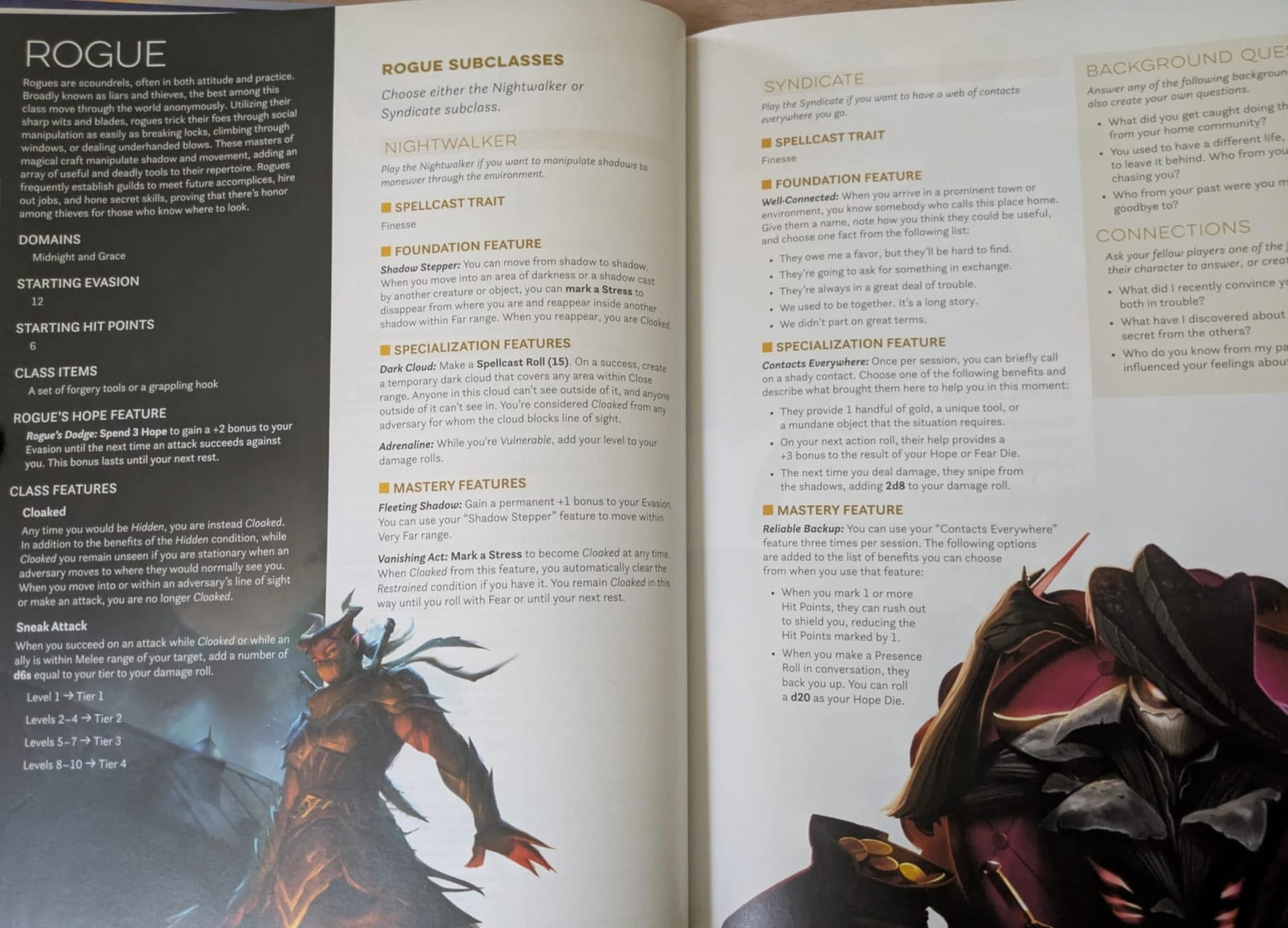
Mechanics: Hope, Fear, and everything in between
The backbone of the game are Hope and Fear dice. For a given task, you’ll roll 2 d12s, one a Hope die and the other Fear. You add your Attribute and/or Experience to the roll for a value, succeeding if you beat a difficulty threshold with the higher die. Hope and Fear will add an effect, whether positive or negative, regardless of whether you succeed or fail. You could fail with Hope, losing the task but gaining some advantage, or succeed with Fear, doing what you set out to do but with a negative consequence. There is room in between of course, bringing with it a remarkable elegance. Like a condensed version of Genesys, this grants your play a wide range of narrative possibilities from the result of a single roll. It also brings real weight to every roll, wherein you have an equal chance to improve or exacerbate the situation.
If this seems unreasonable, it isn’t. Dice rolls in RPGs are not meant to be trivial. If there isn’t narrative impact behind what you’re doing, you shouldn’t be rolling for it. Every dice roll impacts the narrative, but also the players’ and GM’s stock of Hope or Fear points, gained when one of the respective die comes up higher. Hope powers your abilities, and lets you help allies or lean on your Experiences. Fear lets the GM take action for enemies and triggers Fear moves for monsters or environments. It’s also the secret sauce to Daggerheart’s initiative system.
In my preview last year, I was most critical of Daggerheart’s seeming lack of an initiative system. The response I suggested they pivot to is exactly what they went with. I take no credit for that. It’s just that my answer was obviously the appropriate way forward given the way they were building this game, and it works out incredibly in practice. There is no strict initiative for players, indeed, no break from the usual game in terms of action economy. At least, not at first blush. Your players take moves as they will, as it feels appropriate, but rolling Fear gives the GM an option to take a turn and use their resources against you.
Before getting into why this is a good thing, I’ll break down why it seemed like a bad idea at first: not having an initiative system isn’t necessarily a bad idea, but it is when you have a game built with so many of its abilities around combat, and therefore combat math. I don’t just “like” initiative systems. They serve specific purposes depending on the context in which they function. R&S were talking to me about how they want their game broken out of initiative, so let’s use an example of a game where that works. Urban Shadows doesn’t really make combat a different system. It’s just another part of how actions usually take place. Physical conflict isn’t the most interesting part of the game, and they don’t want to break out a huge system about it. Doing that drives decision making. When all you have is a hammer, everything looks like a nail. Many of D&D’s rules, in contrast, are about combat or tie into combat resources. The initiative is necessary because time is a resource in a game about attrition. Every turn that goes by affects the action economy, the HP, your spell duration, rage or ki points, and your patience. Urban Shadows’ combats are only a few rounds, if that, but Daggerheart has tons of rules about HP, Stress, Armor, damage, and therefore an action economy that would balance those factors. With no initiative, you threaten throwing all of those things into a blender and making them meaningless.
Our interview with members of the Daggerheart design team
Luckily, Daggerheart does have an initiative system, just not one they admit to, out of fear of looking too rigid or traditional. In Daggerheart, players can go as often and in whatever order they choose. However, taking more turns puts you more at risk: you’re spending your own resources and giving the GM more Fear, which they can choose to use as it comes, taking small shots at you and whittling you down, or hoard for larger effects. Every action comes with accumulating risks, and the lack of usual structure makes for more decisions with more interesting consequences. This isn’t just a list of who goes when; it’s a challenge about how much you’re willing to risk, at what time, and how well you know your capabilities. Time will tell how all of this plays out. I’ve heard the complaint that this disincentivizes doing anything in combat, but the fact is that taking no action leaves everything up to the enemies anyway. In Daggerheart, you have to modulate your risk and know when to take chances.
Those metacurrencies are fewer and easier to manage than in something like Star Trek 2d20. There you have to pay attention to the difficulty and success values of every roll and constantly track how you spend these points. Hope and Fear play out much more easily, and will change hands quickly with their six point caps. Hope generally spends more quickly and less efficiently than Fear, so long battles will see things shift away from the players, giving you more to think about as you choose to act.
Mike again:
The 2d12 Hope/Fear system was one of the biggest surprises for me- I wasn’t expecting to like it much at all, so attached is my brain to the wonderfully polyhedrous twenty-sided die. Distinguishing one die for ‘Hope’ and the other ‘Fear’ adds a layer to each roll that not only opens up a whole new avenue mechanically, but plays to the narrative nature that is the root of Daggerheart. The lighter d12 represents the hope and potential of you and your party, while the darker one represents the forces in opposition and portends dark times ahead. That duality plays out in every dice roll by players and DM alike, and I love how a successful roll can sometimes be an uneasy victory when that Fear die comes out on top.
All that belies one important feature here: all told, this is still a game wherein the VAST majority of rules text, character abilities, and interactions are exclusively built around combat. Those encounters are the meat of the game. You have flexibility with Hope and Fear, but a few scant references to social encounters are brief exceptions to this game about fighting things.
Damage and armor is the one area that might be overcomplicated. The rules are good, but may go over many players’ heads. You start with six hit points, and variable damage thresholds. If you take high levels of damage, it goes to a higher threshold, and you take more damage, from 1-3. Armor has slots which you can mark off to reduce the damage level. You also have Stress points. Stress is often used as a resource for powers, but can also be reduced by taking damage below your lowest threshold. If you have marked all Stress, it instantly becomes HP damage. The math on this works out to give you meaningful decisions about powers and armor. It also involves a few levels of checking values and remembering options that are going to be obtuse for many players.
Mike again:
I agree with John, here- Every other decision in regards to character management feels streamlined compared to most systems, damage and armor here feel overwrought. I strongly suspect this will ultimately be adhered to differently from table to table, much like encumbrance in D&D.
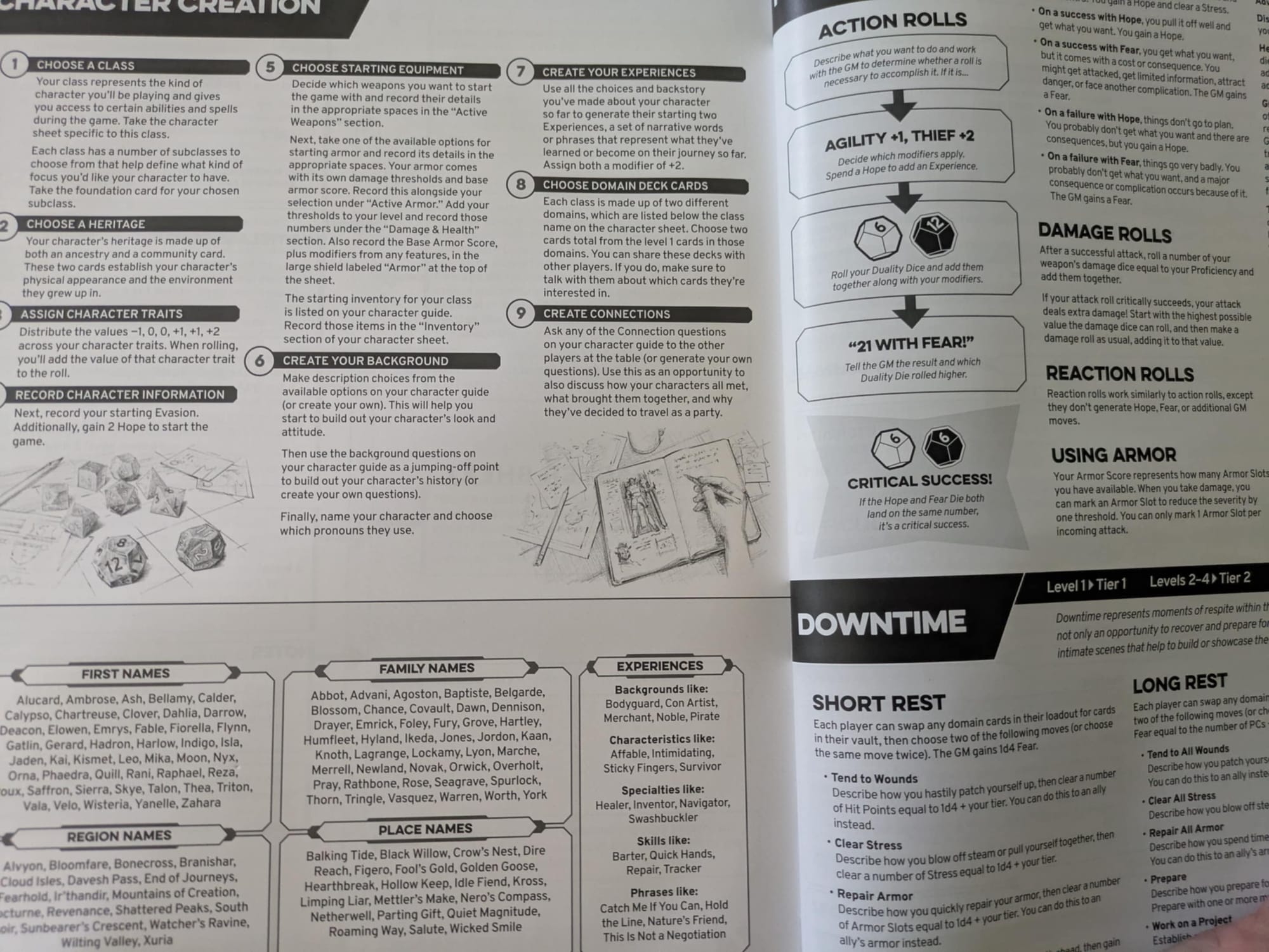
Character Creation
Characters have six attributes (Agility, Finesse, Strength, Instinct, Presence, Knowledge), and you begin by assigning +2, +1, +1, 0, 0, -1 to them. Evasion, functionally AC, comes from class, as well as Hit Points. You will also have thresholds of six for Stress, Hope, and Fear. Instead of specific skills you will choose two Experiences, general realms of knowledge like Gambler or Historian that cover the same ground but with more flexibility.
There are nine classes, each with two subclasses, and 15 Ancestries, functionally races, and nine Communities, i.e. your origin with a minor ability. There is not a lot going on with these. Really the class, subclass, and abilities are how your characters differentiate themselves. The classes are very close to D&D. Arguably too much so. There’s no getting around the fact that this is built as a not-D&D game. That’s entirely what it is. I think it would be better if it were its own thing, but I can’t ignore the fact that it is better at being the type of heartbreaker it’s going for. Most people who play D&D actually want to be playing this game, as a fast, strategic, thematic experience.
Setting, GM Section, & Campaign Frames
The GM section has some good advice on the non-mechanical aspects of running a game. This will be fairly GM heavy, as a tactical game with a lot of mechanics built around the enemies. Campaign Frames are alternate settings with maps, themes, and some minor alternate rules. This doesn’t really have its own setting, which is fine, because they want you to build your own. This is a toolbox for your own adventure, and doesn’t need a specific setting. Again, if this were its own game from the ground up, it would hang together better, but it’s intended as a large toolkit. You can’t actually have a setting with 15 different races all interspersed with no boundaries unless you work really hard at explaining how it works, and they aren’t interested in doing that here. Better this than D&D, which just doesn’t make sense with how many species are right next to each other all the time with no explanation.
There aren’t many equipment options. However, the ones present are more differentiated than D&D’s equipment for sure, but it would be nice to have some more available.
Mike again:
This whole section feels a bit like a placeholder teasing a much bigger exploration in a future volume, and I think that’s fine as the book needs to draw more players in than game masters, and any campaign settings or adventure books that might be in the pipeline are all going to be squarely aimed at the person running the game. This is a good start, but this is where I wish there was a short adventure included that could guide a prospective GM through an example of how to run a game. Interestingly, the book does provide a template and even several examples of how to map out a full campaign, again steering it towards heroic narrative with the Campaign Frame concept. The examples given go into setting detail, but it’s only enough worldbuilding to serve the plot ideas for each. I’ll be shocked if Exandria sourcebooks and Critical Role themed adventures aren’t on the horizon, but for now, Daggerheart is a homebrewer’s game.
Layout, Materials, Components
The book is just under 400 pages, including a quite usable table of contents and index, with colored markers on the sides of the pages to help navigation and two ribbons to mark pages with. Darrington has a lot of funding behind it (you know, as far as tabletop RPG companies go) and used that to full effect. The art and layout are really a cut above, showing you a range of biomes, peoples, and magical styles. The appendices have summaries for character creation, general rules, GM tools, and maps for the example settings. I really have to take a minute and highlight how nice this is. If you take a new player and give them nothing but a character sheet and these tools, they’ll have enough to be able to play without needing to look through anything else. Most thoughtful of all, this Character Sheet Sidecar, a single page you can cut or slide to either side of the character sheet as a direct rules reference. Lovely, honestly. This is a great idea, and I think other designers should steal it outright. How awful is it to give someone a pregen and have their eyes go wide at the display of numbers and terms with no explanation? Ideally, these would all be contained in some way on the sheet itself, as well as a character generation summary, but this is a game with complexities that wouldn’t allow for that.
More interesting are the 189 ability cards, which bring a lot more to the table than it would seem at first. Classes all have Domains, i.e., cards which they have access to, accessible at several levels. When building your character, you can choose from cards within your Domain. This saves a ton of annoyance from the aspect of character creation during which you choose abilities. Instead of having to wait as you pass the book around while someone flips through multiple chapters of spells & abilities, you have it right there in front of you. Everyone can look at the cards that are relevant to them, and you can easily see which domains people are going for. Ideally, there would be a way to make a character only using these cards, but the heritage and class features are minimal enough that they present only a minor stumbling block.
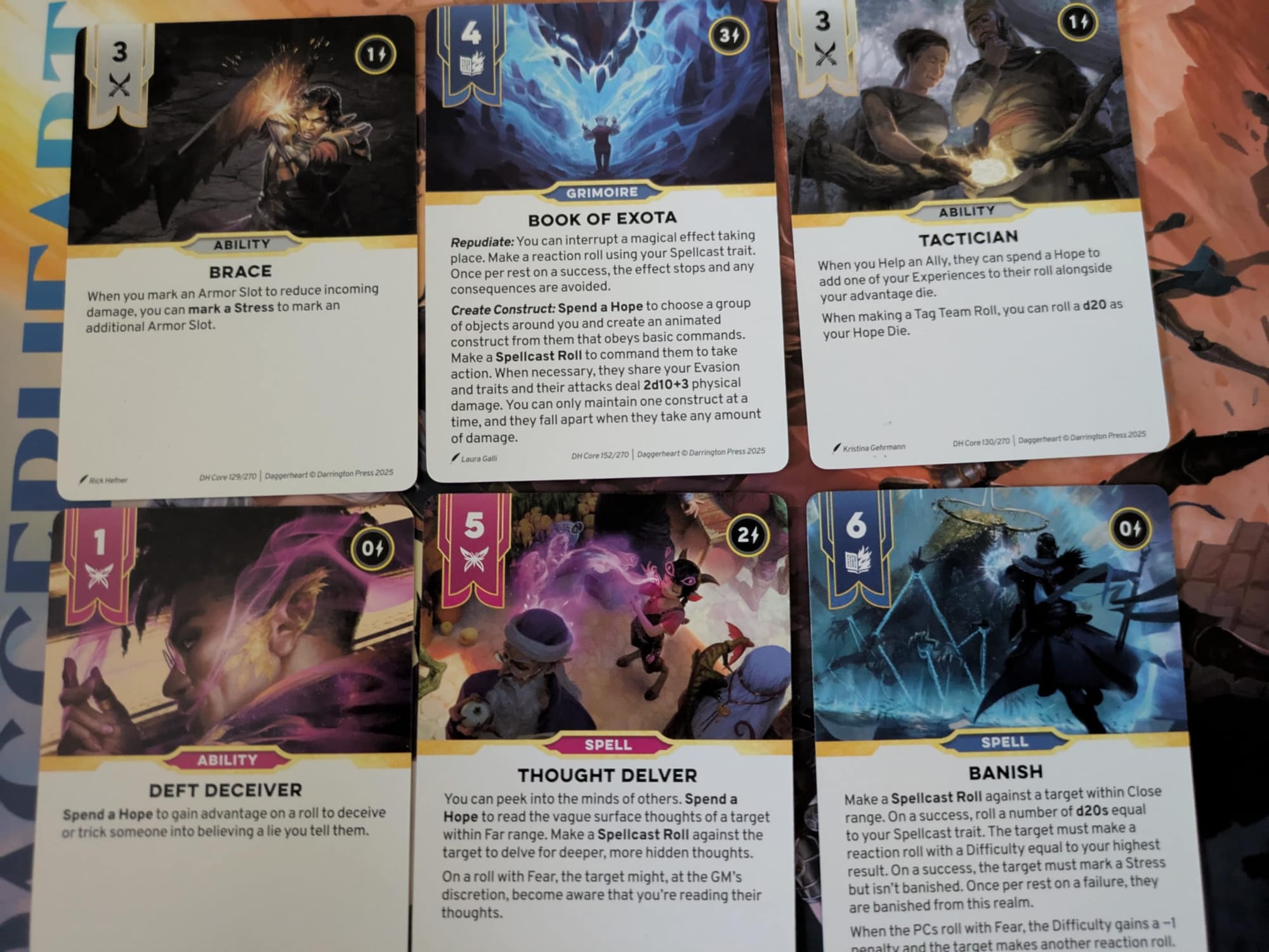
At higher levels, you can also take stress equal to a value on each card to switch out abilities. Diagetically, this doesn’t always make sense, but as a tactical matter it’s so cool I don’t care. This is so interesting and adds so much to the game that it should start at character creation. I’m going to house rule it that way for sure. The card-swapping adds real utility to the cards, which are more than just expensive reference material, and always gives you options to choose from and ways you can be active, looking at abilities instead of building dice towers or playing on your phone. This will also make it easier for people to know what their abilities are. You know, the kind of person who can’t remember or flip through their multi-page character sheet. You do have to store the cards if you don’t write them down, but I already know people looking forward to finding fun ways of displaying them in game. Darrington, credit me if you steal this idea: a foldout binder with character sheet, your reference page/rules summary, and display binding for the cards. People will pay for that accessory, with sleeves on the outside for custom character art that displays Evasion for the GM and has some fun visual way to show Stress levels.
Mike again:
If there is one thing Daggerheart absolutely nails, it’s presentation. I’m not just talking about the visual design and artwork of the book (which more than holds up against the latest D&D core books or Paizo offerings), it’s how the game presents itself to the players at every turn. The character sheet, sidecar, and ability cards provide an experience for the player that goes beyond stats and inventory and adds the context of mechanics where it is needed most in a visually cohesive manner. This isn’t just a character sheet, it’s also a player aid. I’ll be honest, once digital character management tools like D&D Beyond started becoming more common, their utility in the moment of linking off to specific rules and handling calculations programmatically had me cringing at the thought of using pencil and paper ever again. I imagine we’ll see digital tools for Daggerheart in short order, but the optional printable character sheet sidecar is a great idea, and I’d love to see more options that provide different contexts for the situation. As for the cards, this is an idea I have embraced for years with D&D, having long since adopted several third party decks for spells, equipment, monsters and the like (my favorite have been the lenticular spell cards from the Hitpoint Press). It’s a great idea, is easier to work with than paging through a hardcover book, and I applaud Daggerheart for elevating cards as a core tool like this.
In Conclusion
If there’s one flaw to this game, it’s that for all its talk of being a narrative-first story game, this is a combat engine before anything else. There’s a two page spread about social rolls, but exploration and resources are mostly excised or built around combat. Those combats look to be interesting, with interesting abilities, but they are the game. Ancestry and Heritage have almost no mechanical effect, next to the fighting abilities you can get from your class. The actual abilities at your disposal are interesting and thematic. They give you many options to make decisions and influence the battlefield. More than a packet of vancian damage, there are real ways they can open options for you and change how characters play.
Review Guidelines
Excellent
Daggerheart emerges as a polished, inventive contender in the fantasy TTRPG space, marrying elegant mechanics with a strong narrative ethos. Its Hope and Fear dice system adds real tension and storytelling depth to every roll, while the streamlined presentation and card-based abilities improve accessibility and engagement. Though still rooted in a combat-heavy framework and reluctant to fully leave D&D’s shadow, it surpasses 5E in cohesion and player-focused design. With thoughtful development and clear ambition from Darrington Press, Daggerheart signals a promising step toward a smarter, more modern style of fantasy roleplaying.
Pros
- Card switching should be a standard feature
- Almost exclusively combat focused
- The armor rules are well balanced, but cumbersome
Cons
- Hope and Fear integrate tons of possibilities with simple rules
- Card-based character abilities are easy to build with and reference
- Concise, useful, thoughtful rules summaries
This review is based on a retail copy provided by the publisher.
Share this article
Affiliate Links












